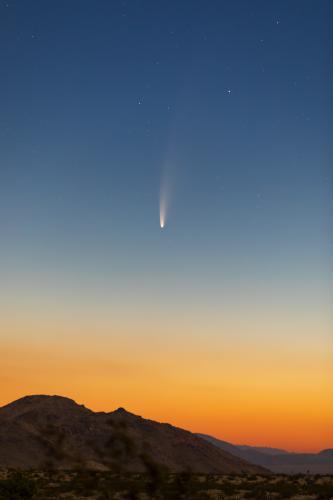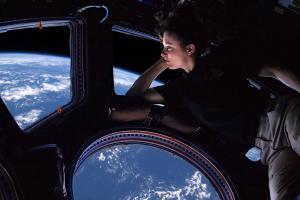Celebration of Space - July 10, 2020
On July 3, 2020, Comet C/2020 F3 NEOWISE, cruised past the Sun at a mere distance of 27,391,909 miles, called Perihelion. We speculated that the comet had a good chance of breaking up due to the intense solar radiation that close to the solar corona. Well the comet survived its perihelion and is now making its way towards Earth, passing by us on July 23, 2020. A good reason why the comet survived its encounter with the Sun is because of its rather large nucleus, which is around 3 miles in diameter. Having a large nucleus will also explain why it’s so bright. Since perihelion, the comet has made its way into the Northern Hemisphere morning sky, and sightings have started. The comet and its nicely developing tail have become dimly naked eye visible. Though a view with binoculars will be fabulous. Sadly, since entering the morning pre-dawn sky, we have been clouded out or fogged out in the mornings over Southern New England (of course!). Regardless, the view is just going to keep getting better as the comet swings past us. Will it become one of the great comets of history? Probably not, but it will be the first naked eye comet to dazzle Northern Hemisphere sky watchers in quite a while. Once we get a clear morning, we will start to capture images of the comet and will post them to our media gallery, Facebook, and Twitter (@FrostyDrewOBSY). Also, if you happen to capture a photo of Comet NEOWISE, post it to the Visitor Posts section of our Facebook and we will share it on our timeline.
On Tuesday, July 14, 2020, Earth will reach the point in our orbit where we end up in between the Sun and Jupiter, with Jupiter being on the opposite side of Earth than the Sun. We call this Opposition, and it marks our closest point to Jupiter for our year, at 384,744,419 miles distant. Additionally, Jupiter will rise with sunset and set with sunrise on that night, giving us views of Jupiter for the entire nighttime period. All of this makes for best viewing of Jupiter during the weeks surrounding opposition. Once opposition passes, Jupiter will be above the horizon at sunset each night, with visible altitude increasing with each passing night. This will make Jupiter a frequent target at Frosty Drew Observatory this summer and autumn. If you haven’t seen Jupiter in a telescope, then be sure to stop in at the observatory and sneak a peek at the fabulous planet with its swirling storms, equatorial bands, and four bright Galilean Moons.
Starting on Sunday, July 12, 2020, welcome the International Space Station (ISS) back to the evening sky over the US with daily passes visible to anybody interested in looking up. Nightly passes, sometimes several per night, will continue until August 5, 2020, giving us a nice summertime showing of the station. Below we will post some of the more notable passes happening over the next week. Note that there are numerous other passes happening than those listed below, though we are only listing passes that are bright and easy to see from most locations.
Sun, Jul 12 at 11:43 pm, emerging from orbital sunrise at 30° over the NNE, heading towards the NE
Mon, Jul 13 at 10:51 pm, starting in the WSW, rising to 58°, heading towards the NE ← Excellent Pass!
Tue, Jul 14 at 10:03 pm, starting in the SW, rising to 84°, heading towards the NE ← Excellent Pass!
Wed, Jul 15 at 9:15 pm, starting in the SW, rising to 48°, heading towards the ENE
Thu, Jul 16 at 10:05 pm, starting in the W, rising to 38°, heading towards the NE
The pass times listed here are applicable for Southern New England, and generally acceptable for the Northeast. Also notice that the first listed time states that the ISS emerging from orbital sunrise at 30°. That’s because the ISS orbits Earth once every 90 minutes and experiences sunrise or sunset once every 45 minutes. When all of us Earthbound sky watchers observe the ISS passing, all we see is sunlight that reflects off the station’s labs and solar panels. For this to happen the ISS needs to be in direct sunlight. As the station drops into Earth’s shadow, it will appear to slowly dim and disappear from our view. Consequently, the opposite of this happens when the ISS starts to emerge from Earth’s shadow back into direct sunlight.
For additional daily pass times applicable to the Northeast, visit https://frostydrew.org/observatory/#satellites. For pass times specific to your location, visit NASAs Spot the Station. Now set your alarm and get out there to see humanity’s only continuously inhabited space-based residence zoom by at 17,500 mph!
- Author:
- Scott MacNeill
- Entry Date:
- Jul 10, 2020
- Published Under:
- Scott MacNeill's Columns




